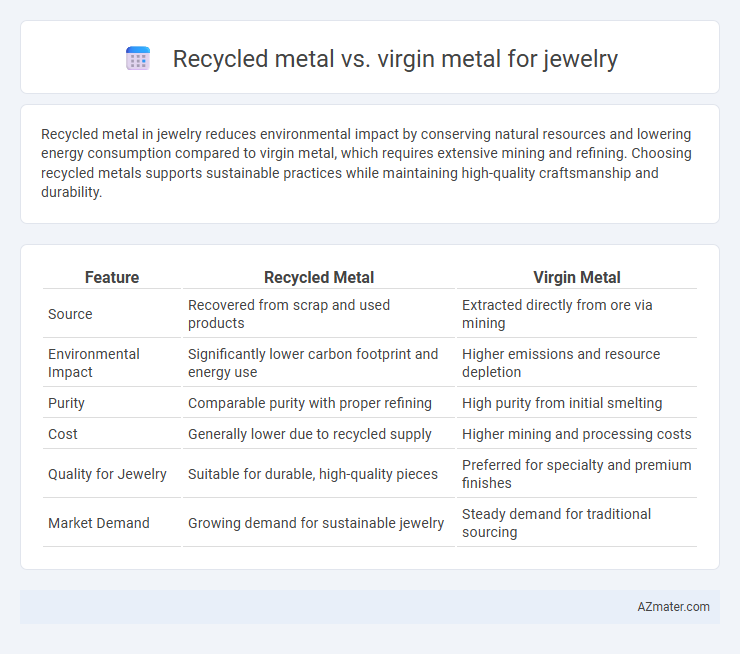Recycled metal in jewelry reduces environmental impact by conserving natural resources and lowering energy consumption compared to virgin metal, which requires extensive mining and refining. Choosing recycled metals supports sustainable practices while maintaining high-quality craftsmanship and durability.
Table of Comparison
| Feature | Recycled Metal | Virgin Metal |
|---|---|---|
| Source | Recovered from scrap and used products | Extracted directly from ore via mining |
| Environmental Impact | Significantly lower carbon footprint and energy use | Higher emissions and resource depletion |
| Purity | Comparable purity with proper refining | High purity from initial smelting |
| Cost | Generally lower due to recycled supply | Higher mining and processing costs |
| Quality for Jewelry | Suitable for durable, high-quality pieces | Preferred for specialty and premium finishes |
| Market Demand | Growing demand for sustainable jewelry | Steady demand for traditional sourcing |
Introduction to Recycled vs. Virgin Metal in Jewelry
Recycled metal in jewelry is sourced from previously used metals that are melted down and repurposed, reducing environmental impact and conserving natural resources. Virgin metal, on the other hand, is extracted directly from mines, requiring intensive energy consumption and contributing to habitat disruption. Choosing recycled metal supports sustainable practices while maintaining the quality and durability expected in high-end jewelry craftsmanship.
Environmental Impact: Recycled vs. Virgin Metal
Recycled metal for jewelry significantly reduces environmental impact by lowering the demand for mining, which consumes vast amounts of water, energy, and disrupts ecosystems. Virgin metal production generates higher carbon emissions and contributes to habitat destruction, soil erosion, and toxic waste. Using recycled metals promotes sustainable resource management by minimizing landfill waste and conserving natural reserves.
Cost Comparison: Recycled Metal vs. Virgin Metal
Recycled metal for jewelry typically offers a lower cost compared to virgin metal due to reduced mining and refining expenses, which substantially decrease raw material and production costs. Virgin metal often involves higher extraction and processing fees, contributing to its premium price in the jewelry market. Choosing recycled metal not only cuts costs but also supports sustainable practices by minimizing environmental impact.
Quality and Durability Considerations
Recycled metal for jewelry maintains comparable quality to virgin metal when properly processed, often undergoing rigorous refining to remove impurities that could affect durability. Virgin metal typically offers consistent purity and structural integrity, ensuring optimal strength for intricate designs and prolonged wear. Both options can achieve high durability, but recycled metal quality heavily relies on the refinement process and alloy composition.
Ethical Sourcing and Social Responsibility
Recycled metal in jewelry reduces environmental impact by minimizing mining activities, conserving natural resources, and lowering carbon emissions linked to extraction processes. Virgin metal often involves extensive mining operations associated with habitat destruction, labor exploitation, and toxic waste, raising significant ethical concerns. Choosing recycled metals supports social responsibility by promoting fair labor practices, reducing ecological damage, and aligning with sustainable supply chains in the jewelry industry.
Consumer Preferences: Trends in Sustainable Jewelry
Consumer preferences increasingly favor recycled metal over virgin metal in sustainable jewelry due to environmental and ethical concerns. Recycled metals reduce mining impact and energy consumption by up to 85%, aligning with the growing demand for eco-friendly fashion. Market surveys reveal a 45% increase in consumer willingness to pay premium prices for recycled metal jewelry, driven by heightened awareness of resource conservation.
Production Processes for Recycled and Virgin Metals
Recycled metal in jewelry production involves melting down scrap metals, significantly reducing energy consumption by up to 85% compared to extracting and refining virgin metals from ore. Virgin metal production requires extensive mining activities, ore processing, and smelting, which contribute to higher greenhouse gas emissions and environmental degradation. The streamlined recycling process not only conserves natural resources but also minimizes hazardous waste generation, making recycled metals a more sustainable choice for jewelry manufacturing.
Certification and Traceability in Metal Sourcing
Recycled metal in jewelry is often certified by organizations such as the Responsible Jewellery Council (RJC) and utilizes blockchain technology to ensure full traceability from source to finished product, reducing environmental impact and promoting ethical practices. Virgin metal sourcing requires stringent auditing and certification processes, including conflict-free sourcing standards like the Kimberley Process for diamonds, to guarantee responsible extraction and supply chain transparency. Choosing certified recycled metal enhances supply chain accountability and supports sustainable consumption in the jewelry industry.
Design Possibilities and Creative Potential
Recycled metal in jewelry offers expansive design possibilities by allowing artisans to experiment with unique textures and sustainable materials that convey eco-conscious values. Virgin metal provides consistent quality and malleability ideal for intricate, high-precision designs requiring pristine metal purity. Combining recycled metal's creative potential with virgin metal's reliability enables jewelers to innovate while maintaining structural integrity and aesthetic appeal.
Making an Informed Choice for Jewelry Buyers
Recycled metal in jewelry reduces environmental impact by minimizing mining and energy consumption compared to virgin metal, making it a sustainable choice for eco-conscious buyers. Virgin metals offer unparalleled purity and are often preferred for their traditional value and consistent quality in high-end pieces. Jewelry buyers should consider their priorities, balancing environmental benefits with desired metal characteristics when making an informed purchase decision.

Infographic: Recycled metal vs Virgin metal for Jewelry
 azmater.com
azmater.com